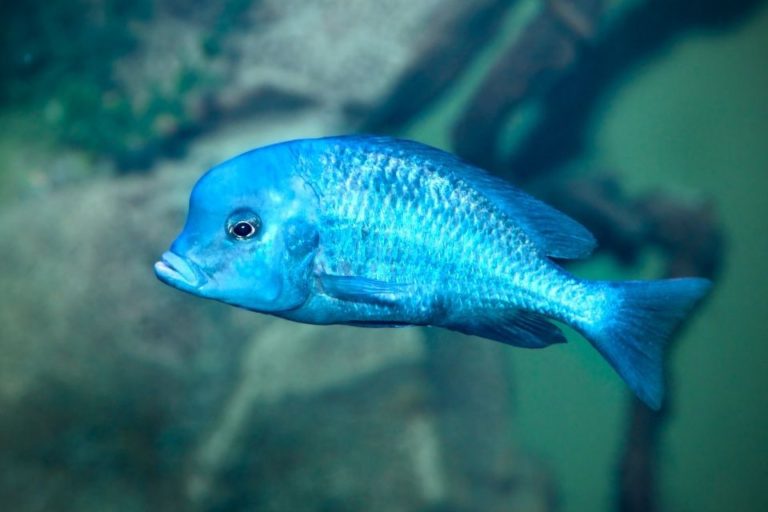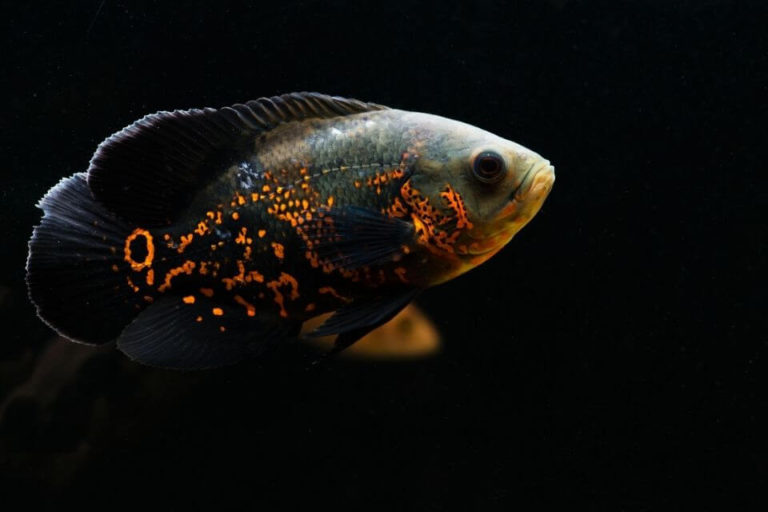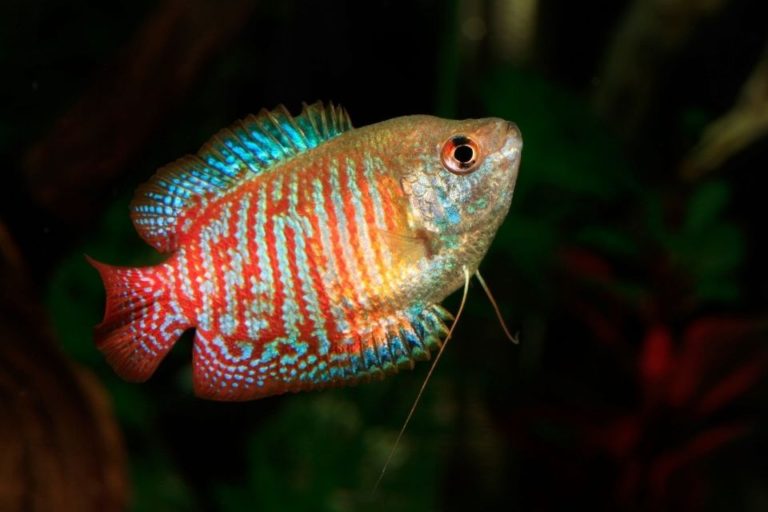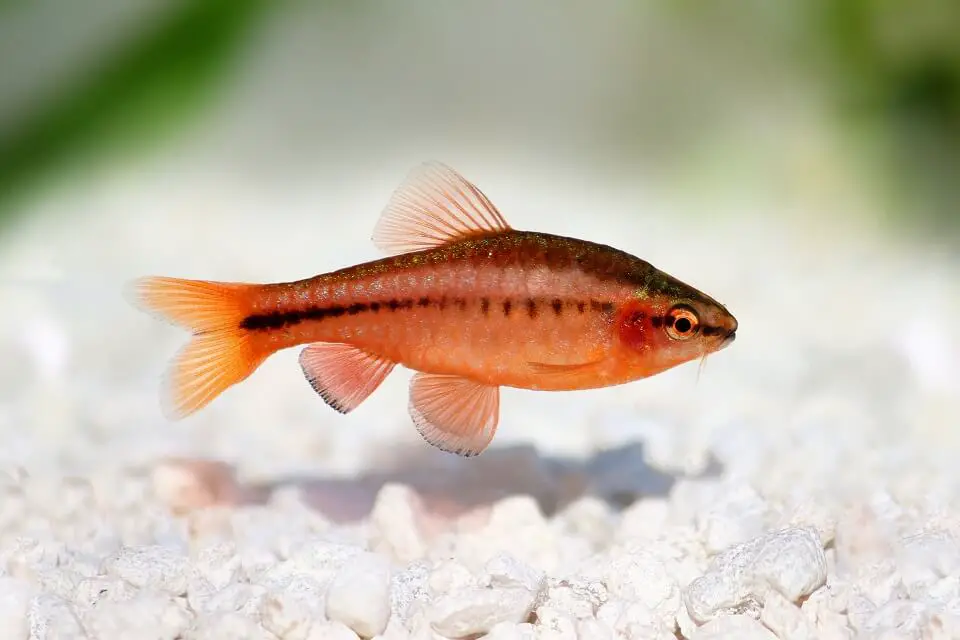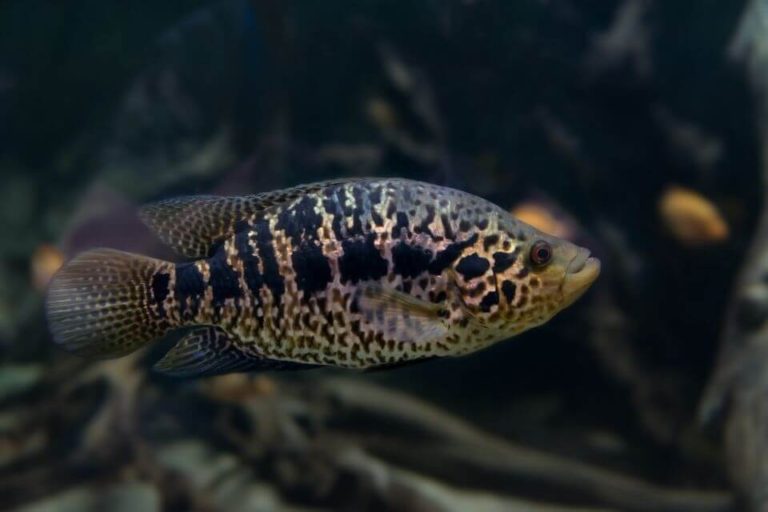Serpae Tetra Care Guide – Setting Up A Tank, Tank Mates and Feeding

The Serpae Tetra is a flame-colored freshwater fish species that is a common addition to aquariums. It is one of the most colorful tetras and looks stunning when added to an aquarium with many live aquarium plants.
Serpae Tetras are known for their schooling nature and will generally swim in the middle to the bottom section of your Aquarium.
It is not just about good appearance and behavior for this fish. It is easy to care for and very beginner-friendly. Any aquarist looking for low-maintenance and good-looking fish can never go wrong with Serpae Tetras.
In this guide, we’ll cover all the care and maintenance details of the Serpae Tetra, so read through if you are looking to keep this fish as your next freshwater aquarium fish.
| Quick Facts: | |
|---|---|
| Common Names | : Red Serpae, Red Minor Tetra, Serpa Tetra, Jewel Tetra, Callistus, Callistus Tetra, Blood Characin |
| Scientific Name | : Hyphessobrycon eques |
| Family | : Characidae |
| Origin | : Guapore and Paraguay River basins |
| Care Level | : Easy |
| Lifespan | : 5 to 7 years |
| Size (average) | : 1.5 - 2 inches |
| Diet | : Omnivorous |
| Breeding | : Egglayer |
| Social | : Schooling fish |
| Temperament | : Peaceful |
| Minimum Tank Size | : 10 gallons |
| Temperature | : 72 – 79 °F (22 – 26 °C) |
| Water Hardness | : 5 - 25 dGH |
| Water pH Level | : 5.0 - 8.0 |
Overview of Serpae Tetra
Other names: Red Serpae, Red Minor Tetra, Serpa Tetra, Jewel Tetra, Callistus, Callistus Tetra, and Blood Characin
The Serpae Tetra is a colorful freshwater fish species from the Characidae family and Scientific names as Hyphessobrycon eques. This fish is of Brazil and Paraguay native, but thanks to its appealing characteristics, it’s widespread worldwide.
The three primary colors of this fish are brown for the body, black for the dorsal fin, and red for the caudal and anal fins. Despite its small body (generally less than 2 inches), the fish can live up to 5 to 7 years.
Serpae Tetras do not call for much in terms of care and maintenance and the care you give any other tank fish will serve them just fine.
The Serpae Tetra is generally considered peaceful and loves to swim in schools of 6+ members. As long as there is enough space, the fish can also be a good community fish. On the flip side, this fish can be a good fin nipper when they get aggressive or when kept in small groups.
Serpae Tetras are not picky when it comes to feeding. They will eat anything from fish pellets, frozen and dried foods to live foods. Breeding is also relatively easy for this fish.
Origin, Distribution, and Availability
Serpae Tetras originate from South America and are commonly found in the Amazon drainage basin. They mostly populate the Guapore and Paraguay River basins that stretch from Argentina, Brazil, to upper Paraguay.
In natural habitats, they take most of their time hiding from predators in murky water, around tree roots, and thick vegetation. Since there are no threatening predators in aquarium conditions, the fish is always full of energy and ready to amaze at all times.
This fish is bred widely in North America, Europe, and Asia but is today a popular global freshwater aquarium fish.
The species of this fish currently in the market are hybrids and not pure wild varieties. This means that they are still populated in their wild environment and not endangered in any way.
The price of a young Serpae Tetra for sale from $2.5 to $7.5. The price is, however, dependent on the pet shop you are buying it from. You can find Serpae Tetra for sale at reputed online pet sellers at reasonable prices.
Serpae Tetra Typical Behavior
Like Neon and Cardinal Tetras, Serpae Tetra is a calm and peaceful fish. Serpae Tetras prefer to live in a community tank with a school and other fast-moving fish. The fish also exhibits playful behaviors, especially when they are swimming in schools with their own companion.
When you keep Serpae Tetras in small schools and alone, they will spend most of their time taking shelter, a thing you would not want happening in a display aquarium. If you have heard Serpae Tetras being associated with fin nipping, it will only occur when kept in this condition.
Serpae Tetras can sometimes be easily frightened, so adding hiding places by including lots of plants and other decorations in your tank will work for them when the environment gets uncomfortable.
The fish is a mid-level to bottom dweller. You will only get it in the tank’s upper tank when feeding. All in all, the scenery they create in a display tank is invaluable.
Characteristics of Serpae Tetra

– Appearance
The Serpae Tetra is referred to as a deep-bodied fish with the shape of a standard Tetra. The body is flat, elongated, and oval or trapezoidal shaped.
The colors and the special markings are the most striking appearance features of this fish, as explained below.
– Colors and Special Markings
Although the theme color may vary from one breed to another, a Serpae Tetra will have a striking-reddish brown color. The scales on their body have a shiny luster that reflects light and creates very beautiful scenery when they swim under correct lighting conditions.
The fins for this fish have a mix of colors that add to its uniqueness. The dorsal fin is generally black with white edges, while the other fins are red. The anal fish has black edges and a white leading tip.
When it comes to markings, there is just one predominant feature- a black comma-shaped spot just behind its gills. The mark is most vibrant when the other body and fins colors are fully developed.
The colors and marking (especially the black spot behind the gills) of this fish fade as they age and are something you should factor in when purchasing a new Serpae Tetra stock. Only go for the vibrantly colored fish and the ones that look healthy.
– Size: How Big Do Serpae Tetras Get?
When it comes to Serpae Tetra size, it is a small fish species. If well fed and taken care of, it will grow up to 1.5 to 2 inches.
– Lifespan of Serpae Tetra
Captive-bred Serpae Tetra generally has a lifespan of 5 to 7 years. In some reports, seasoned fish keepers report a lifespan of even 10 years for this fish.
Aquarium Care and Conditions for Serpae Tetra
When it comes to aquarium care, it is recommended to stick to the below-discussed points to give Serpae Tetras the best of care.
– Tank Conditions and Care
Serpae Tetras need plenty of hiding places in their tank as they sometimes get easily scared. The most straightforward way to achieve this is by adding lots of live Aquarium plants to their tanks. Decoration (discussed below) can also serve as hiding places.
In order to keep the tank clean, you need to include a highly effective filtration system. A good filter will decompose nitrates present in the fish’s waste and any organic matter in the tank.
Filters also help deal with fluctuations of the set conditions in the tank. Since Serpae Tetras prefer slow-flowing water, you should include a filter that does not add too much agitation.
– Serpae Tetra Tank Size
A 10 gallons tank will cater to all the swimming and shelter needs of a whole school of at least 5 to 6 Serpae Tetras. To give them quality swim space I would recommend that you consider a tank of 20 gallons. That will allow you to accommodate 6 to 12 Serpae Tetras in a school.
As a guide, you should do your calculation on a 1-gallon per 1-inch of fish length basis.
Before purchasing a tank for Serpae Tetras, be sure of the number you want to bring in as overcrowding the fish with stress them out and affect their health significantly.
Also, if you want to keep this fish in a community tank, ensure that their space requirements are fulfilled and the other members comfortable and well catered for in terms of space needs.
– Tank Setup
Serpae Tetras are naturally used to a dark and sandy substrate in wild habitats and this is what should be added in their Aquarium. Note that their colors will pop better if the substrate in conjunction with the lighting is contrasting.
The Serpae Tetra fish, just like many tetras, will thrive in low or dim lighting. Use subdued lighting to simulate the natural habitat’s conditions and bring out the best look of the fish’s colors and markings.
To provide relatively constant conditions in the tank, you have to monitor the lighting system to ensure that it does affect the water’s temperature.
You can decorate this fish tank with driftwood. This does not just add an aesthetic element (adding a natural look in the tank) but also increases the shelter for this fish.
Even better, the driftwood will bring in tannins in your tanks that are crucial in maintaining the required pH level in the tank. You can also add logs and rock formations as decorations and add to shelter as well as the hiding places.
– Suitable Plants
Live plants are a perfect addition to a Serpae Tetras tank as they add shelter and hiding places. You need to add as many plants in your Serpae Tetra as you can, but please keep them at the sides as this fish prefers to swim in the middle section of the tank.
You can include any favorite tetras plants in a Serpae Tetra’s tank:
- Anacharis
- Java fern
- Anubias Petite
- Hornwort
- Ludwigia Repens
- Amazon Sword
Since the fish prefers to spend most of its time near the tank’s surface, it would help if you added floating plants to support this dwelling behavior.
Note that plenty of floating plants will also block light from getting into the tank during the day.
– Water Conditions and Parameters
The secret to making your Serpae Tetras happy and healthy at all times is replicating what they are used to in the wild to the Aquarium. With the following water parameters, in addition to the tank setup above, your Serpae Tetras will be tricked that they are on their natural habitats:
- Temperature: 72 – 79 °F (22 to 26 degrees Celsius)
- Water pH: 5 to 8
- Hardness: 5 to 25 dGH
Understand the nature of the Serpae Tetras you have in your tank and maintain just what they are used to. Test the parameters outlined above frequently to ensure that the environment you subject your Serpae Tetras to is stable and in a supportive condition.
You can also improve water quality by changing it partially 25-50% twice a week.
Before bringing in Serpae Tetras, set up your tank and give the water inside some time to cycle through. This will prevent major fluctuations from affecting your newly acquired stock.
Diet and Feeding
Like other fish species feeding Serpae Tetra fish is very important. We must provide them well a balanced and nutritious diet as discussed below:
– What Do Serpae Tetra Eat?
The Serpae Tetra is an omnivore and will eat a variety of foods under tank conditions. They will work with fish pellets, frozen and dries foods, flakes, and fresh foods.
In the wild, this fish snacks on plant matter, invertebrates, and live foods such as insects and worms. It would help if you replicated this in your Aquarium feeding.
You can take high-quality pellets and flake foods as their primary foods then occasionally feed them with treats such as brine shrimp and bloodworms. A balanced diet is, however, preferred as it helps keep the fish healthy and vibrantly colored at all times.
– How Often Should You Feed a Serpae Tetra?
Just like any other omnivore fish, the Serpae Tetra fish prefers small feedings several times a day. The term ‘small’ simply means that you need to feed these fish with an amount that they will eat entirely in a few minutes.
Serpae Tetra Diseases
Although Serpae Tetra fish have no specific diseases, they are prone to all common freshwater fish ailments. It is needless to say that the risk of contracting these diseases will be higher when the water/tank conditions and quality of feeds deteriorates.
Common illnesses for Serpae Tetra include Ich, skin flukes, fungal infections, and parasite infestations.
To keep your Serpae Tetras free from these diseases, keep checking water parameters/conditions and ensure that they are stable and at the required level.
Always engage a reputable veterinary when you notice any behavioral or appearance changes on your Serpae Tetras. Don’t embark on treatment unless you are certain of what condition you are dealing with.
If you are bringing Serpae Tetras as an addition to your community freshwater tank, quarantine them in a separate tank for at least two weeks.
During this period, monitor the fish closely and check if any member has signs of diseases. Treat any sick individual before introducing the stock back to your community tank.

How Do You Tell If a Serpae Tetra Male or Female?
The male and female varieties of the Serpae Tetra fish are very similar and it is hard to tell them apart, especially when they are growing to reach maturity.
However, on reaching maturity, the females appear rounder and larger than the males. Males have a fully black dorsal fin when they are ready to spawn, while females have a pale one.
The males at any growth stage will have more vibrant colors than the females and if you have a sharp eye, this is something you’ll notice.
Serpae Tetra Breeding
As mentioned above, Serpae Tetras are easy to breed even in a home aquarium. It’s not a wonder to see Serpae Tetra fry in a mature fish tank. This tells you that they don’t need very ‘special’ conditions to spawn or reproduce.
Even with this, you need to make the breeding more strategic and yielding by following the following requirements.
Select breeding pairs or groups (equal number of males and females) who are healthy and with fully developed colors.
Set up a small tank with a dull substrate and dim lighting. A tank of 10 gallons will be enough for the breeding process. Add spawning mops or aquarium plants such as Myriophyllum and Java Moss for the fish to form a platform where the eggs will be deposited.
Adding dry leaf litter in a Serpae Tetra fish breeding tank is also very beneficial. First, this will add to the simulation of the natural habitats other plants create in the tank and also produce microbe colonies that are a perfect source of food for Serpae Tetra fry.
For faster-spawning you should set the following conditions in the spawning tank:
- Water hardness: 6 – 8 dGH (the water should be soft)
- Temperature: 80 °F (27 degrees Celsius)
- Acidity: Around 6.0
When the females are ready for spawning, they will appear plump and rounder. The Serpae Tetra female is an egg scattering spawner and is not the best when it comes to parental care.
Once the Serpae Tetra eggs are scattered all over, remove the parents (they may eat the eggs) and completely dim the light as they are sensitive to bright light.
Serpae Tetra eggs will take 1 to 2 days to hatch, after which the fish will start feeding on their yolk sack or any safe microbes in the tank. You can also introduce fresh brine shrimp and finely crushed flake foods for the young ones to feed on.
Frequently asked questions
There are a few questions and concerns that we highlighted and thought to discuss below.
– How Many Serpae Tetras Should I Keep Together?
Serpae Tetras are schooling fish and should be kept in groups of 6 or more individual fish. This is the only way to keep them happy and your tank, peaceful.
dsThe lowest number you can go for a group of Serpae Tetras is 4, as anything lower than this will lead to fin nipping and other aggressive behaviors. The maximum number will depend on the size of the singly occupied or community fish tank you have.
– What Fish Can Live with Serpae Tetra (Compatible Tankmates)?
Perfect Serpae Tetra tank mates are fish that show the same energy level as them and that that does not exhibit any form of competitive characteristics and behavior.
Serpae Tetra compatible tank mates should preferably be bottom dwellers, peaceful and short-finned.
Considering these requirements, the best fish to keep with Serpae Tetras are Corydoras Catfish, Loaches, Giant Danios
If you have a large community tank, you can keep the Serpae Tetras among compatible tetras such as Cardinal Tetras, Neon Tetras, Back Skirt Tetras.
Just like any other fish, the ideal tank mates for the Serpae Tetra should not be too large or too small.
– Can Serpae Tetras Live with Bettas?
Keeping Serpae Tetras with Bettas is not a nice idea as these two are not compatible. Here are the supporting reasons:
- Bettas are brightly colored and most of their body features look like those of the Serpae Tetras. When kept in the same tank, there will be a lot of confusion and a high possibility of chaos sprouting. Any aggressive behavior a Serpae Tetra will direct to another Serpae Tetra is definitely what Bettas will get.
- The other reason is that Bettas are slow swimmers and not as full of energy as the Serpae Tetras. Keeping the two in the same tank would therefore mean that the Serpae Tetras will cause a lot of trouble to your Bettas.
- Lastly, Bettas tend to compete with Serpae Tetras for food, which may spell trouble for these two fish.
– Are Serpae Tetras Fin Nippers?
Yes, when kept in small groups. Serpae Tetras love school, so keeping them in groups of two or three would definitely evoke this form of aggression.
Note that fin nipping is only directed to other Serpae Tetras and may barely occur in a community tank. Expect to see this behavior when they are feeding.
– Are Serpae Tetra Aggressive?
Serpae Tetras are generally peaceful fish and will live with their company or other compatible fish just fine. This, of course, has to be supported by good tank and water conditions, proper feeding, and provision of enough swimming space.
Just as fin nipping, any form of aggressive behavior this fish may have is always directed to other Serpae Tetras. Keeping this fish in a community tank will definitely keep their aggressive side at bay.
Final Thoughts
The Serpae Tetra is a great beautiful fish to add to a freshwater home aquarium. There is no doubt that these fish are one of the most lively and fun to watch, especially when they form school and swim together.
Correctly feeding and maintaining the tank conditions discussed in this guide will take care of the aggressive behavior that the Serpae Tetra may sometimes have.
Tetras are generally schooling fish. To keep them comfortable, you need to keep them in groups of 6 or more in a tank. This implies that keeping Serpae Tetra with other tetra species may end up overcrowding your tank since each of these species will need to be kept in schools.
Here, the ideal approach is to keep Serpae Tetras only in a tank or with other fish that do not live in schools.
For the best experience, keep these fish in large schools, include tons of aquarium plants in the aquarium, and provide much room for them to swim and display their beauty. All the best!


